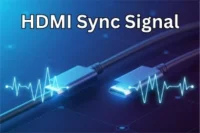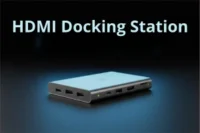HDMI & Optical: What’s the Difference in Audio Quality?
Published: 28 Sep 2025
When it comes to getting the best sound experience, selecting the right audio connection is important. There is often confusion about HDMI vs Optical Audio, as both are commonly used for connecting audio devices.
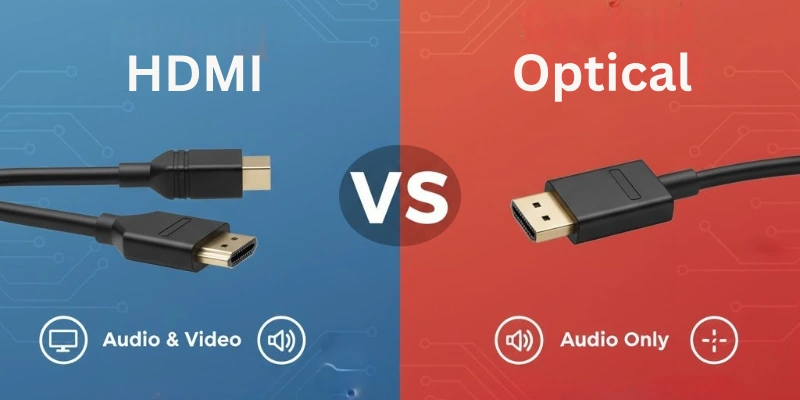
This article highlights the major differences between HDMI and Optical audio connections to help you choose the best option for your needs.
What is HDMI and What is Optical?
When you connect a TV or sound system, you may see two common options: HDMI and Optical. Both are used to send sound from one device to another, but they work in different ways.
What is HDMI?
HDMI means High-Definition Multimedia Interface. It is a cable that sends both sound and video through one wire. People use HDMI to connect TVs, speakers, soundbars, game consoles, and other devices. HDMI gives high-quality sound and works well with modern sound systems.
What is Optical?
Optical, also called TOSLINK, is another type of audio cable. It sends only sound, not video. It uses light signals instead of electricity. Optical cables are often used to connect a TV to a speaker or home theater. It also gives good sound, but not as many sound features as HDMI.
HDMI vs Optical: What’s the Difference?
Now let’s look at how HDMI and Optical are different from each other. Below are the main points that make them different:
- Signal Transmission
- Audio Quality & Formats
- Video Transmission
- Cable Type & Design
- Device Compatibility
- Ease of Setup
- Remote Control Integration (CEC)
- Cable Length & Interference
Let me guide you about each difference between HDMI and optical cable in detail.
1. Signal Transmission
Signal transmission means how the sound travels from one device to another — like from your TV to a speaker or soundbar. HDMI and Optical cables send these signals in different ways.
Let’s see how each one works:
HDMI – How it Sends Signals
Here is how HDMI sends signals:
- HDMI uses electrical signals to send both sound and video.
- It sends high-quality digital signals.
- It supports new sound formats.
- It can carry more sound data, which means better sound quality.
- It can also send extra signals.
Optical – How it Sends Signals
Here is how Optical sends signals:
- Optical uses light signals (not electricity) to send sound only.
- It sends digital sound, but it is limited in what formats it supports.
- It does not support advanced sound features.
- It gives clear sound, but not as rich or detailed as HDMI.
- It cannot send remote control signals or video.
2. Audio Quality & Formats
Audio quality means how clear and powerful the sound is. Audio formats are the types of sound signals your devices can play, like normal sound or 3D surround sound.
HDMI – Audio Quality and Formats
Here is how HDMI performs:
- HDMI gives better and richer sound than Optical.
- It supports modern audio formats like: Dolby Atmos, DTS:X, Dolby TrueHD, DTS-HD Master Audio.
- These formats give cinema-like surround sound.
- Perfect for home theater systems.
Optical – Audio Quality and Formats
Here is how Optical performs:
- Optical also gives good quality sound, but not as advanced as HDMI.
- It supports basic formats like: Dolby Digital, DTS 5.1 Surround Sound.
- It does not support advanced formats like Dolby Atmos or DTS:X.
- Suitable for basic audio setups, not for modern home theaters.
3. Video Transmission
When talking about video transmission, it means sending video signals (picture/video) from one device to another, like from your DVD player or game console to a TV.
HDMI – Video Transmission
Here is how HDMI works for video:
- HDMI can send video signals along with audio using the same cable.
- You don’t need an extra cable for video.
- It supports high-definition video (HD, 4K, even 8K).
Optical – Video Transmission
Here is how Optical works for video:
- Optical does not send video at all.
- You must use a separate cable (like HDMI or other) for video if you use Optical for audio.
4. Cable Type & Design
Cable type and design mean how the cable looks, what it is made of, and how it works inside. HDMI and Optical cables are different in design and working style.
HDMI – Cable Type & Design
Here is how HDMI cable looks and works:
- HDMI cables are made with electrical wires inside.
- The cable has a wide, flat connector at the end.
- It is thicker and stronger, but can be less flexible sometimes.
- It carries both audio and video signals.
- Comes in different versions (HDMI 1.4, 2.0, 2.1) for better quality.
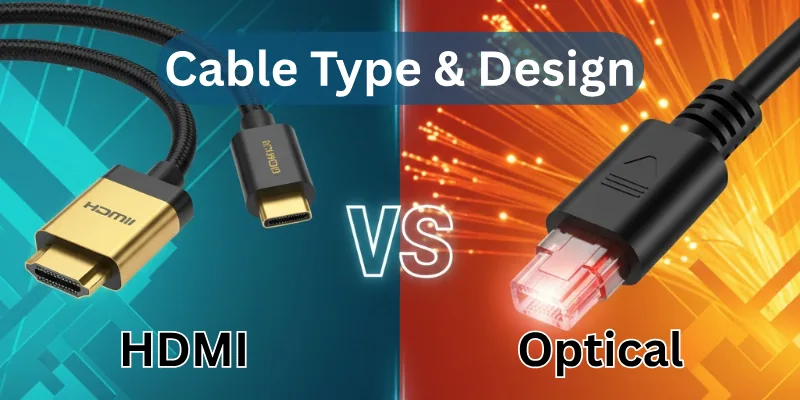
Optical – Cable Type & Design
Here is how Optical cable looks and works:
- Optical cables are made with glass or plastic fiber inside.
- They use light signals instead of electric signals.
- The cable has a round connector (TOSLINK) at the end.
- It is usually thinner and more flexible.
- Only carries audio signals, not video.
5. Device Compatibility
Device compatibility means which devices support or work with HDMI and Optical cables.
HDMI – Device Compatibility
Works with almost all modern devices, like:
- TVs
- Soundbars
- Home theater systems
- Game consoles (like PlayStation, Xbox)
- Blu-ray/DVD players
- Laptops and PCs
HDMI is the most common and widely supported connection type today.
Optical – Device Compatibility
Found in many older devices and some audio systems. Works with:
- Older TVs and soundbars
- Home theater receivers
- CD/DVD players
- Some gaming consoles (older models)
Newer devices may not include Optical ports, so it has limited use now.
6. Ease of Setup
Ease of setup means how quickly and simply you can connect the cable and make it work with your devices.
Here’s a quick comparison of setup steps:
HDMI – Ease of Setup
Setting up HDMI is quick and simple:
- Just plug one end into your device and the other into your TV or speaker.
- No extra settings needed in most cases.
- Auto-detection works well on most modern systems.
Optical – Ease of Setup
Setting up Optical takes a few more steps:
- Plug the cable into the right ports on your device and audio system.
- You might need to go into sound settings and select Optical as the audio source.
- Some systems may require manual adjustments for proper sound.
7. Remote Control Integration (CEC)
CEC (Consumer Electronics Control) is a feature that lets you control multiple devices with one remote — like using your TV remote to control a soundbar or DVD player.
HDMI – Remote Control Integration (CEC)
Here is how HDMI supports CEC:
- HDMI supports CEC feature, which means you can use one remote for many connected devices.
- For example, turning off your TV can also turn off your sound system automatically.
- Makes everything more user-friendly and convenient.
Optical – Remote Control Integration (CEC)
Here is how Optical handles remote control:
- Optical cables do not support CEC.
- You need separate remotes for each device (TV, soundbar, DVD player, etc.).
- No automatic control or syncing between devices.
8. Cable Length & Interference
This part explains how far the cable can carry signals clearly and how outside interference (like signals from other devices) can affect the sound quality.
HDMI – Cable Length & Interference
Here is how HDMI performs:
- HDMI cables work best up to 15 feet (around 4-5 meters) for strong signals.
- If the cable is too long, signal quality may drop, especially for high-quality video.
- Can be affected by electromagnetic interference (from other electronic devices).
Optical – Cable Length & Interference
Here is how Optical performs:
- Optical cables can work well up to 10 to 16 feet (3 to 5 meters).
- Longer cables may weaken the light signal, causing sound issues.
- Not affected by electromagnetic interference, because they use light, not electricity.
- More stable in areas with many electronics around.
HDMI Cable vs Optical Cable: Quick Comparison Table
Here is a comparison table for the hurry learners who want a quick look at “HDMI or Optical”.
| Feature | HDMI | Optical |
| Signal Type | Digital (electrical) | Digital (light-based) |
| Audio Quality & Formats | Supports high-quality formats (Dolby TrueHD, DTS-HD) | Supports standard formats (Dolby Digital, DTS) |
| Video Support | Yes (audio + video in one cable) | No (audio only) |
| Cable Type | Thicker, electrical cable | Thin, fiber-optic cable |
| Ease of Setup | Simple plug-and-play | May need manual settings |
| Device Compatibility | Widely supported on modern devices | Mostly used in older devices |
| Remote Control (CEC) | Supported (control devices with one remote) | Not supported |
| Cable Length | Good up to ~15 ft (interference possible) | Good up to ~16 ft (no interference) |
| Interference Protection | Can be affected by other signals | Not affected (uses light) |
| Overall Use Case | Best for modern home theaters, soundbars, TVs | Good for older audio setups |
Which Audio Cable Costs More – HDMI or Optical?
When it comes to price, both HDMI and Optical cables are usually affordable, but HDMI cables can be slightly cheaper, especially the basic ones.
You can find a good quality HDMI cable at a lower cost than a high-end Optical cable. However, prices can vary depending on brand, length, and quality.
Also, HDMI offers more features (like video and CEC control), so it often gives better value for money.
HDMI ARC vs Optical
While reading or searching for HDMI vs Optical, many of you may have also come across the term HDMI ARC.
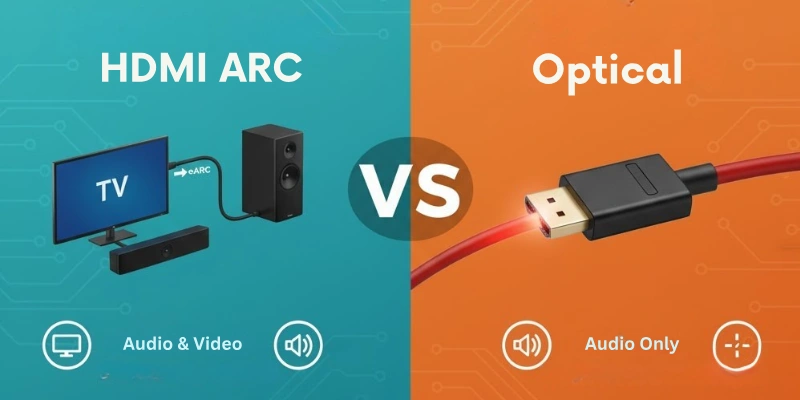
If you’re wondering how HDMI ARC is different from Optical, here’s a quick and simple comparison to clear your confusion:
HDMI ARC (Audio Return Channel) is a feature found in many modern TVs.
- It allows sound to travel back from the TV to a soundbar or speaker.
- Only one HDMI cable is needed — no need for an extra audio cable.
- It also supports remote control features and better audio formats.
Optical Audio is already explained above while comparing it with HDMI.
- It is a separate cable used only for sending sound.
- It does not support extra features like HDMI ARC.
- It offers limited audio format support and no remote control function.
Quick Comparison Table:
Here is a quick overview guide:
| Feature | HDMI ARC | Optical Audio |
| Audio Quality | Supports better audio formats (like Dolby Digital, Dolby Atmos) | Standard surround sound only |
| Extra Features | Allows remote control (CEC), lip sync fix | No CEC or extra features |
| Ease of Use | One cable for audio and control features | Only audio connection |
| Compatibility | Modern TVs and soundbars | Works with old and new devices |
Conclusion
In this article, we explained the key differences between HDMI vs Optical sound in an easy and clear way. You now know how they work, how they compare in terms of quality, setup, and features.
As an expert suggestion, I’d recommend HDMI (or HDMI ARC) if you want better sound formats and extra features like remote control. But if you just need a basic sound connection, Optical is still a good choice.
Don’t forget to check out the FAQs section below — it answers many common questions!
FAQs
So, guys are some of the commonly asked questions related to Optical and HDMI differences:
HDMI gives better sound quality because it supports newer audio formats like Dolby Atmos. It can also carry both sound and extra features like remote control signals. Optical gives good sound too, but it doesn’t support advanced formats. So overall, HDMI is better for sound.
HDMI is the best choice if you want higher sound quality and easier setup. It supports more features and works well with modern devices. Optical cable is still good for basic audio. But if your devices support HDMI, it’s the better option.
Yes, some devices allow both to be connected. But usually, only one connection will work at a time. You must select the audio output in your TV or sound system settings. It’s better to use just one to avoid confusion.
Yes, HDMI gives better sound because it supports high-quality audio formats like Dolby TrueHD. Optical does not support these formats. HDMI also helps with extra features like syncing sound and video better.
Optical is not fully outdated, but it is older technology. It still works fine for basic sound. But for new features and better formats, HDMI is more future-ready. Most new TVs and sound systems now prefer HDMI.
Yes, Optical can carry basic surround sound like Dolby Digital. But it cannot carry newer formats like Dolby Atmos or DTS:X. For better surround sound experience, HDMI is a better option.

- Be Respectful
- Stay Relevant
- Stay Positive
- True Feedback
- Encourage Discussion
- Avoid Spamming
- No Fake News
- Don't Copy-Paste
- No Personal Attacks

- Be Respectful
- Stay Relevant
- Stay Positive
- True Feedback
- Encourage Discussion
- Avoid Spamming
- No Fake News
- Don't Copy-Paste
- No Personal Attacks



